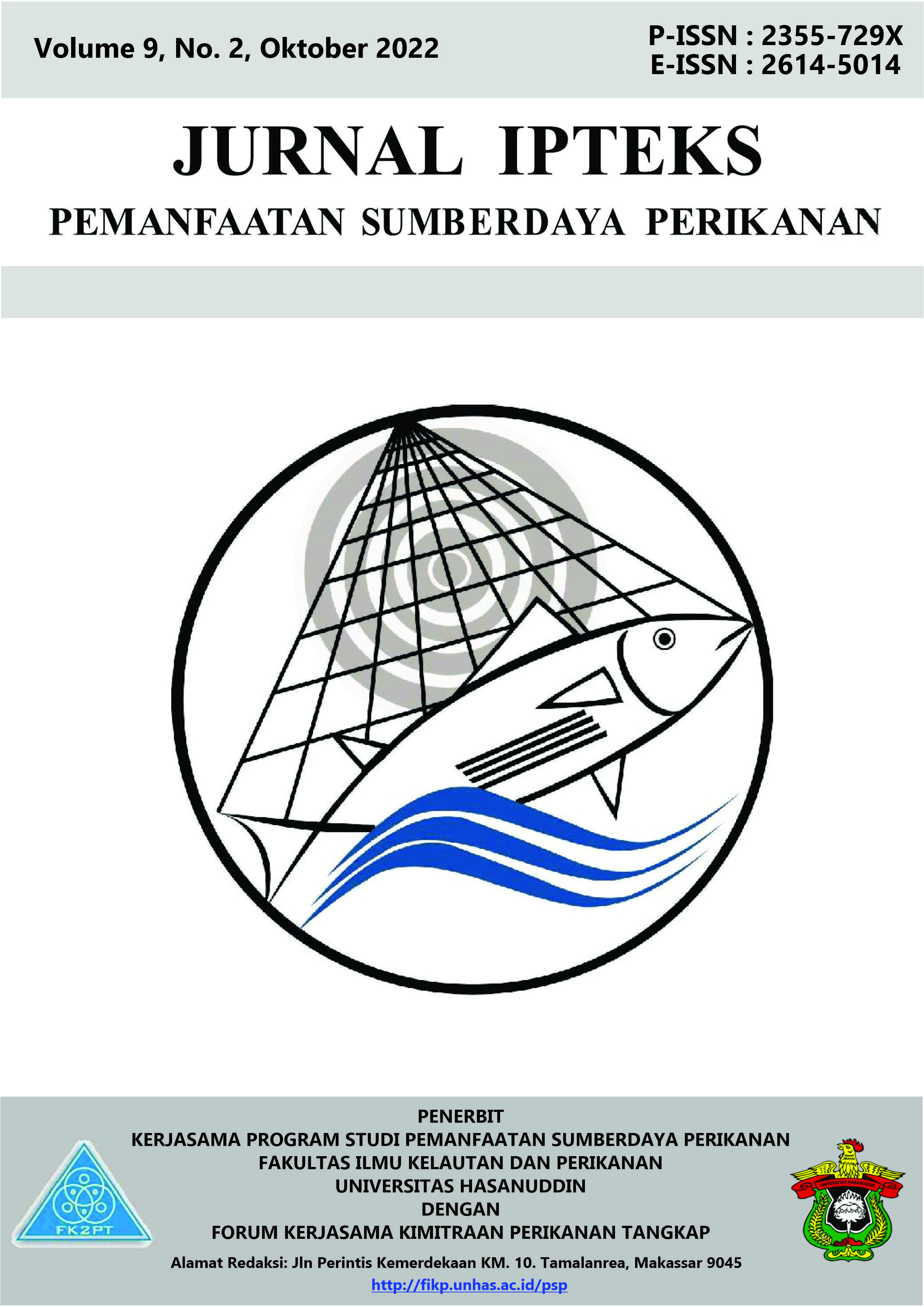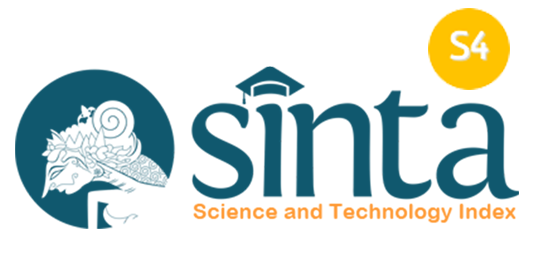ANALYSIS OF THE CYSTOCARP DEVELOPMENT OF SEAWEED (Kappaphycus alvarezii) ON MEDIA ENRICHED WITH A COMBINATION OF NITROGEN AND PHOSPHATE
DOI:
https://doi.org/10.20956/jipsp.v9i2.22373Keywords:
Cystocarp, Kappaphycus alvarezii, Nitrogen, PhosphateAbstract
Seaweed (Kappaphycus alvarezii), in terms of providing seeds in cultivation activities, is still carried out vegetatively, namely cutting the thallus (cuttings), which is then cultivated until it is ready to be harvested (Rao & Reddy, 1997). However, such a method will experience problems, especially the provision of quality seeds on a large scale, and it does not depend on the season. The possible alternative to do is by generative seeding method. K. alvarezii can be developed for cultivation by utilizing the nature of generative reproduction through the development of carpospores, characterised by cystocarps on the surface of the thallus. However, the cystocarp that has been formed needs nutrients in the development process to produce spores of good quality and quantity. Nutrients that are needed to support cystocarp development include nitrogen and phosphate. The benefits of nitrogen and phosphate for seaweed growth cannot be replaced with other elements. This is due to the role of nitrogen as a constituent of protein and phosphate as an energy provider. This study aimed to determine the optimum nitrogen and phosphate enrichment ratio for cystocarp development. The research was carried out from November 2018 to February 2019 at the Seaweed Laboratory of the Takalar Brackish Aquaculture Fisheries Center (BPBAPT). The research location is Mappakalompo Village, Galesong District, Takalar Regency, South Sulawesi Province. They were analyzed at the water quality laboratory of Hasanuddin University to analyse the N and P content in the media. There were 6 treatments with 3 replications each, namely Treatment A: Without enrichment (SW), Treatment B: 1N=0.5 ppm: 1P=0.5 ppm, Treatment C: 2N=1 ppm: 1P= 0,5 ppm, Treatment D : 3N=1,5 ppm : 1P=0,5 ppm, Treatment E : 1N=0,5 ppm: 2P = 1 ppm, and Treatment F : 1N=0,5 ppm : 3P = 1.5 ppm. The results showed that the development of a shorter cystocarp phase was found in treatment D, which was 14 days. Meanwhile, treatment with a long time of 17 days occurred in treatment A (SW).Downloads
References
Bayraktar, Hanefi, Sezer, Turalioglu 2005 A Boyd, C.E. 1990. Water Quality in Ponds for Aqua-culture. Birmingham Publishing Co. Birming-ham, Alabama.
Djafar, F. 2011. Study of nitrogen and phosphate retention of seaweed (Kappaphycus alvarezii) at various water flow velocities. Thesis. Postgraduate Program in Aquatic Sciences, Bogor Agricultural University, Pages 41 - 43. Bogor, West Java.
Effendi, H. 2003. Study of Water Quality for Management of Aquatic Resources and Environment. Canisius. Yogyakarta.
Gusriana. 2006. Seaweed Cultivation. Synergy Library, Bandung.
Hariyati, R. 2014. The Effect of Salinity Differences on the Number of Spores of Gracilaria sp. Department of Biology, Faculty of Science and Mathematics, Diponegoro University. Proceedings of Semnas Entrepreneurship Page: 248-254.
Hartomo & Widiatmoko. 1994. Membrane Technology. Andi Offset, Yogyakarta.
Harwinda, F K, Satyantini W H, and Masithah E W. 2017. The effects of salinity and temperature shock on Kappaphycus alvarezii seaweed spores release. Department of Fish Health Management and Aquaculture, Faculty of Fisheries and Marine Airlangga University, Surabaya 60115.
Lakitan B. 2010. Fundamentals of Plant Physiology. King Grafindo Persada. Jakarta.
Prihatman, K. 2000. Light Manipulation to Stimulate the Growth of Aquatic Plants. Office of the Deputy Minister of Research and Technology for the Utilization and Socialization of Science and Technology (BAPPENAS). Jakarta. 13 Pg.
Rajagukguk, Mark Magi. 2009. Analysis of Indonesian Seaweed Competitiveness in International Markets. [Thesis] Bogor: Faculty of Economics and Management, Bogor Agricultural University.
Rao, M.U. and Reddy B.S., 1997. Infuence of Dessication, Salinity and Temperature on the Liberation and Germination of Tetraspore of Dictyotadichotoma. Indian J. Marine Science 26 : 312 -314.
Rini Pramesti and Nirwani, 2007. Study of the Reproductive Organs of Gracilaria gigas Harvey in the Carposporophyte Phase. Journal of Marine Science Vol. 12 (2) : 93-96. Department of Marine Science, Faculty of Fisheries and Marine Sciences, Diponegoro University. Semarang.
Sulistijo. 1996. Development of Seaweed Cultivation in Indonesia. In: Introduction to the Types of Indonesian Seaweed. Oceanology Research and Development Center, Indonesian Institute of Sciences, Jakarta, pp. 45-50.
Susanto, A. B and Mucktiany. 2002. Seaweed Development Strategy in Vocational High School and Community Callege. Pros. National Marine Science and Technology Seminar.
Syamsuddin, R. 2013. Spore Discharge and Development, and Carrageenan Content Of Seaweed Kappaphycus alvarezii Illuminated With Different Light Colors. Faculty of Marine Sciences and Fisheries, Hasanuddin University. Makassar.
Wibowo, E K, Suryono, and Endah Setianingrum MR. 2009. Application of Differences in N, P and K Compositions in Cultivation of Eucheuma cottonii in Teluk Awur Waters, Jepara. Department of Marine Sciences, Faculty of Fisheries and Marine Sciences, Diponegoro University, Tembalang Campus, Semarang, Indonesia. Vol. 14(3):164-169.
Yunizal. 2004. Alginate Processing Technology. Marine and Fisheries Research Agency. Jakarta.
Yunus, Indah Wahyuni Abida, and Firman Farid Mushoni. 2010. Effect of Phosphate (TSP) on the Growth of Seaweed Echeuma cottonii. Department of Marine Sciences, Trunojoyo University, Bangkalan, Madura. Marine Journal, Volume 3, No 2.
Downloads
Published
Issue
Section
License
Copyright (c) 2022 Jurnal IPTEKS Pemanfaatan Sumberdaya Perikanan

This work is licensed under a Creative Commons Attribution 4.0 International License.










